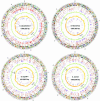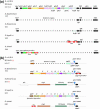Genome dynamics and diversity of Shigella species, the etiologic agents of bacillary dysentery
- PMID: 16275786
- PMCID: PMC1278947
- DOI: 10.1093/nar/gki954
Genome dynamics and diversity of Shigella species, the etiologic agents of bacillary dysentery
Abstract
The Shigella bacteria cause bacillary dysentery, which remains a significant threat to public health. The genus status and species classification appear no longer valid, as compelling evidence indicates that Shigella, as well as enteroinvasive Escherichia coli, are derived from multiple origins of E.coli and form a single pathovar. Nevertheless, Shigella dysenteriae serotype 1 causes deadly epidemics but Shigella boydii is restricted to the Indian subcontinent, while Shigella flexneri and Shigella sonnei are prevalent in developing and developed countries respectively. To begin to explain these distinctive epidemiological and pathological features at the genome level, we have carried out comparative genomics on four representative strains. Each of the Shigella genomes includes a virulence plasmid that encodes conserved primary virulence determinants. The Shigella chromosomes share most of their genes with that of E.coli K12 strain MG1655, but each has over 200 pseudogenes, 300 approximately 700 copies of insertion sequence (IS) elements, and numerous deletions, insertions, translocations and inversions. There is extensive diversity of putative virulence genes, mostly acquired via bacteriophage-mediated lateral gene transfer. Hence, via convergent evolution involving gain and loss of functions, through bacteriophage-mediated gene acquisition, IS-mediated DNA rearrangements and formation of pseudogenes, the Shigella spp. became highly specific human pathogens with variable epidemiological and pathological features.
Figures



References
-
- Sansonetti P.J. Slaying the Hydra all at once or head by head? Nature Med. 1998;4:499–500. - PubMed
Publication types
MeSH terms
Substances
LinkOut - more resources
Full Text Sources
Other Literature Sources
Molecular Biology Databases
Miscellaneous

